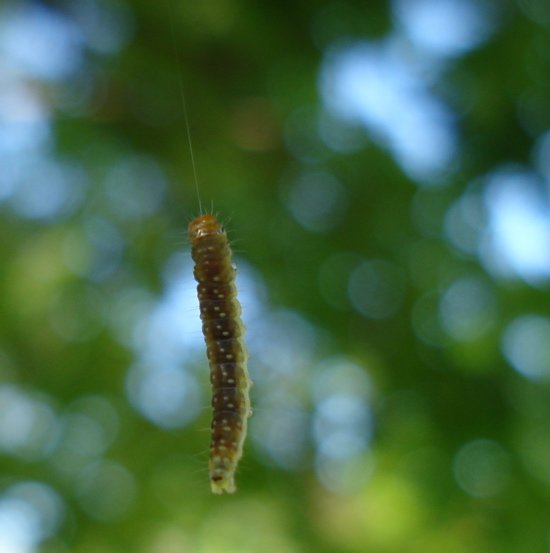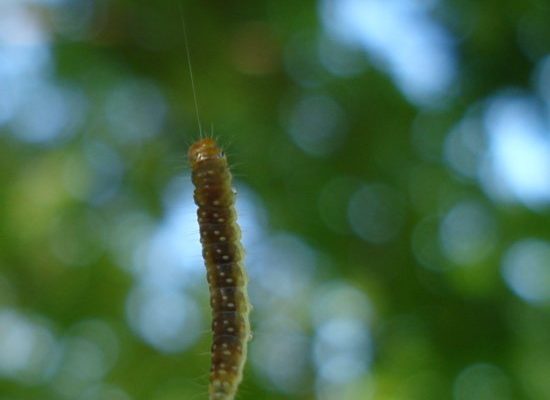
Inchworms belong to the caterpillar stage of certain moths and butterflies, and their silk trails serve multiple purposes. Just like how we use maps to find our way around, these trails help inchworms navigate their surroundings. Imagine walking through a dense forest and needing to mark your path; that’s exactly what our little friends are doing with their silk. Let’s dive deeper into these intriguing silk trails and explore why they matter so much.
What Are Inchworm Silk Trails?
Inchworms produce silk from specialized glands located in their mouths. This silk is quite different from what you might think of when you imagine silkworms in a textile factory. Inchworm silk is fine, almost like a web, and while it’s not meant to be spun into clothing, it’s essential for the inchworm’s life.
You might picture the inchworm crawling along a branch or leaf. It often moves in a unique “inching” motion that saves energy and helps it blend into its surroundings. As it crawls, it releases silk—a sticky, adhesive thread. This silk trail helps the inchworm maintain a *secure grip* on the surface it’s climbing, preventing it from slipping off. It’s like having safety rails on a high path, ensuring they stay safe and secure as they travel upwards.
The Purpose Behind the Silk Trails
So, why do inchworms go through the trouble of making these silk trails? There are several key reasons:
1. Navigation: Just like a breadcrumb trail helps you find your way back, the silk allows inchworms to retrace their paths. If they venture out to find food or a mate, they can follow their silk back home.
2. Safety: The silk can also serve as a lifeline. If an inchworm finds itself in a precarious situation, it can use the silk to lower itself down to safety. Think of it like a bungee cord that helps them escape danger.
3. Communication: Believe it or not, these silk trails can also communicate information to other inchworms. They can signal the presence of food or areas that are safe to explore.
These functions represent the many layers of purpose behind that seemingly simple silk thread, showcasing how even small creatures have intricate survival strategies.
Navigating the World with Silk
Have you ever been in a maze? You probably used markers to find your way out. Inchworms do the same with silk. As they explore their environment, they can leave behind a trail that helps them remember where they’ve been.
In the wild, inchworms often face challenges like predators and environmental hazards. The silk trail is not only a guide but also a tool for evasion. If they sense danger, they can choose to follow their silk back to a safe, hidden spot. Imagine feeling lost in a crowded place and having a bright string to follow back to safety; that’s what inchworms experience in their natural habitat.
Additionally, the silk they leave behind can help them climb surfaces more efficiently. The sticky nature of the silk adds friction, reducing the risk of slipping. Without those trails, inchworms might find it tough to navigate the foliage they call home and could easily lose their footing.
The Directional Aspect of Silk Trails
Let’s get into the nitty-gritty of how inchworms decide which direction to go. They often use environmental cues, like light, temperature, and even other plants, to guide them. The silk trails can help them orient themselves as they navigate through these signals.
When an inchworm moves, it can follow the silk trail, ensuring it stays on a path that leads toward food or safety. If you’ve ever taken a wrong turn while driving, you know how confusing it can be without a GPS. Inchworms use their silk as a personal navigation system. The silk keeps them grounded and helps them make choices about where to go next.
Interestingly, some researchers believe that the trail itself can also influence the direction an inchworm chooses to travel. For example, if one inchworm finds a good food source and lays down a trail, others may choose to follow it. It’s like a group of friends taking the same route to a new café because one of them heard it was good!
Common Challenges for Inchworms
While inchworms have adapted well to their environment, they aren’t without challenges. Here are a few obstacles they face and how their silk trails help:
- Predators: Birds and other natural enemies are always on the lookout for a meal. The silk can help inchworms escape quickly by allowing them to slide away to safety.
- Environmental Changes: Weather conditions can impact their food sources. Silk trails can lead inchworms to more favorable conditions, like a sunnier spot or a safer branch.
- Competition: With many inchworms in the same area, resources can be limited. Following a silk trail to a food source can be crucial for survival.
Inchworms are tough little creatures, and their silk trails play a vital role in helping them navigate these challenges. By following their own paths and responding to the environment, they enhance their chances of survival.
Comparing Inchworms to Other Caterpillars
If you’ve ever seen other caterpillars, you might wonder how inchworms stack up. In contrast to inchworms, many caterpillars don’t produce silk as they move. While some do create webs for safety or nesting, they generally rely on different methods for navigation and protection.
Inchworms’ unique motion also sets them apart. They inch forward with a characteristic looping style, which is not only adorable but helps them conserve energy. Other caterpillars, on the other hand, might crawl continuously without the same movement pattern or silk trail.
You might find yourself asking, “Why does any of this matter?” Understanding these differences can give us better insights into the ecosystems they inhabit. Recognizing how each caterpillar adapts to its environment provides a broader picture of biodiversity and resilience in nature.
The Future of Inchworms and Silk Trails
As we think about inchworms and their silk trails, it’s essential to remember that they’re part of a larger ecosystem. Their ability to navigate, communicate, and survive is crucial not just for them but for the plants and animals that rely on them.
As climate change and habitat loss continue to threaten wildlife, understanding the role of inchworms and their silk trails can help us appreciate and protect these little creatures. Every inchworm contributes to the health of its environment, making it vital for us to recognize their importance.
Inchworms might seem small, but their silk trails create big ripples in their ecosystem. By understanding these unique aspects of their lives, we can foster a deeper appreciation for nature and the delicate balance that sustains us all.
Closing Thoughts
From navigation to survival, inchworm silk trails tell a fascinating story of determination and adaptability. It’s amazing how something so small can have such a significant impact on its environment. Next time you see an inchworm inching along, take a moment to appreciate the silk trail it leaves behind. It’s more than just a thread; it’s a lifeline, a guide, and a symbol of resilience in the natural world. So, let’s celebrate these little heroes and the intricate paths they weave through life!

